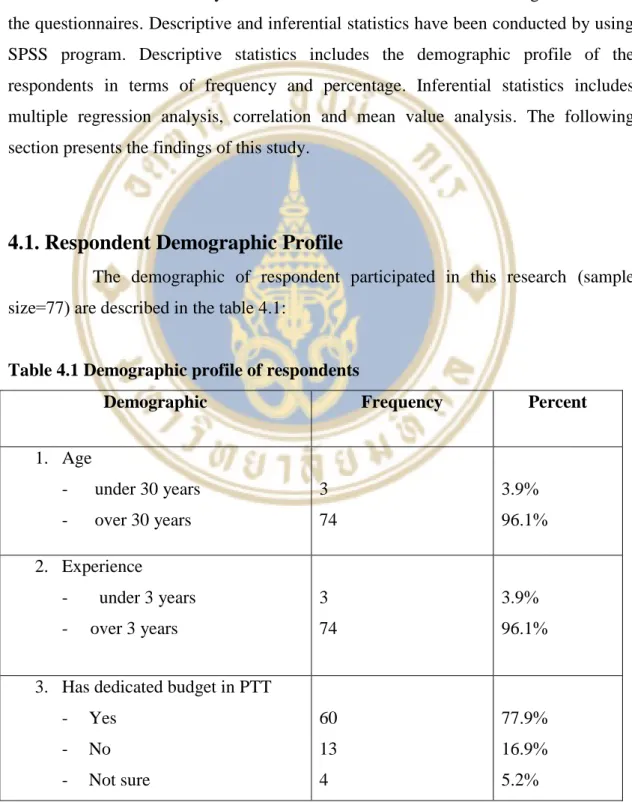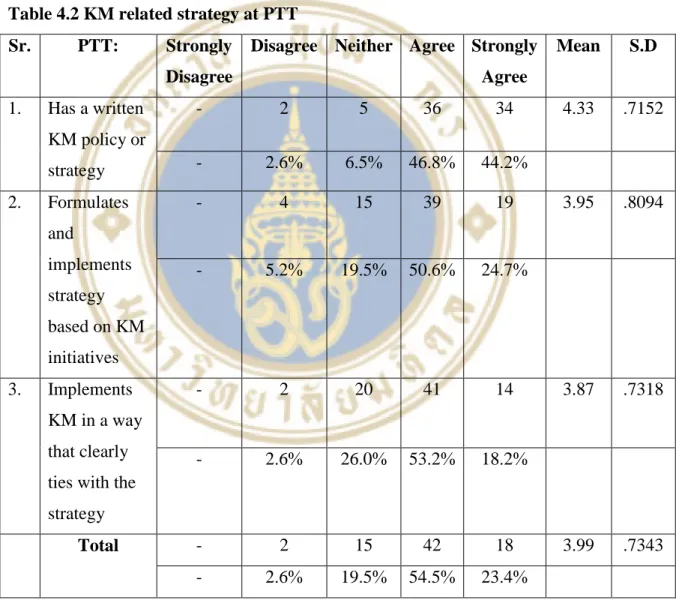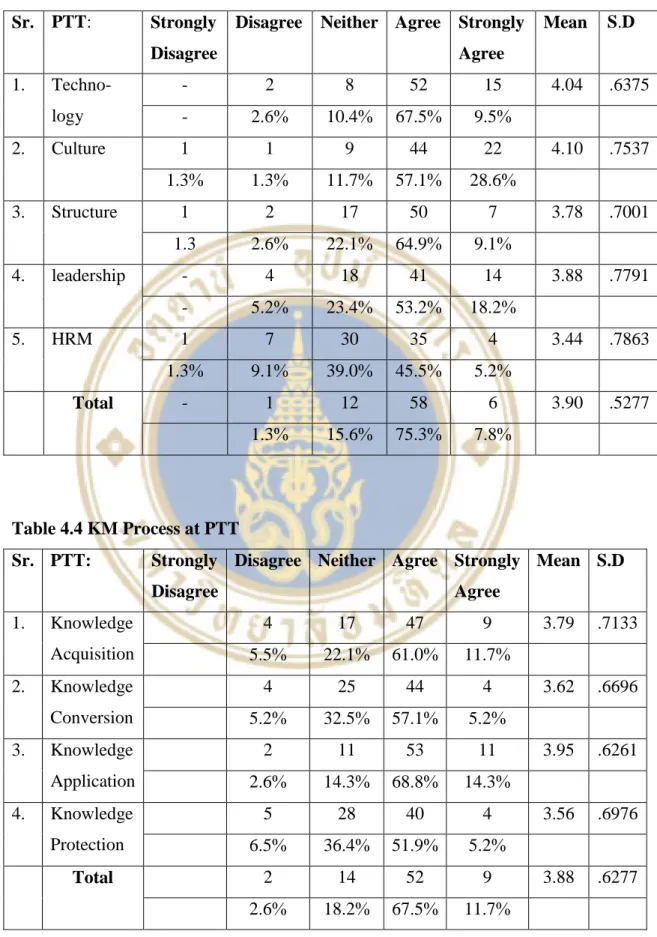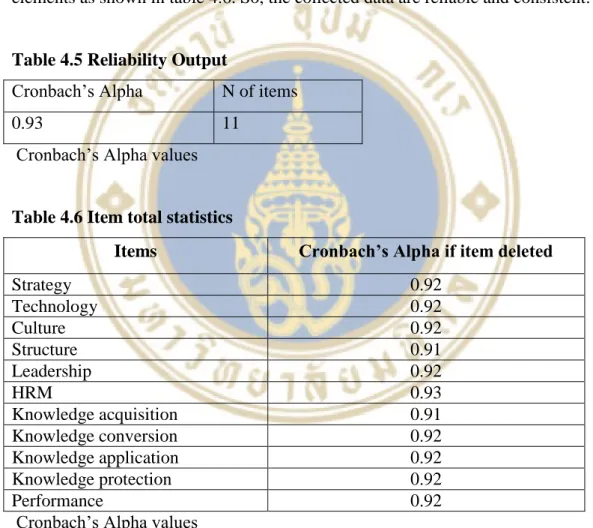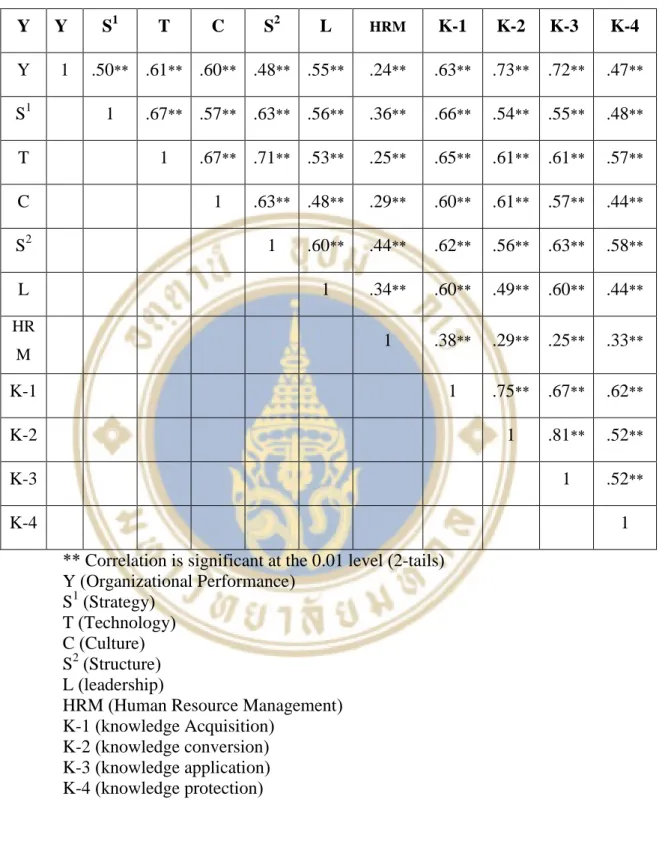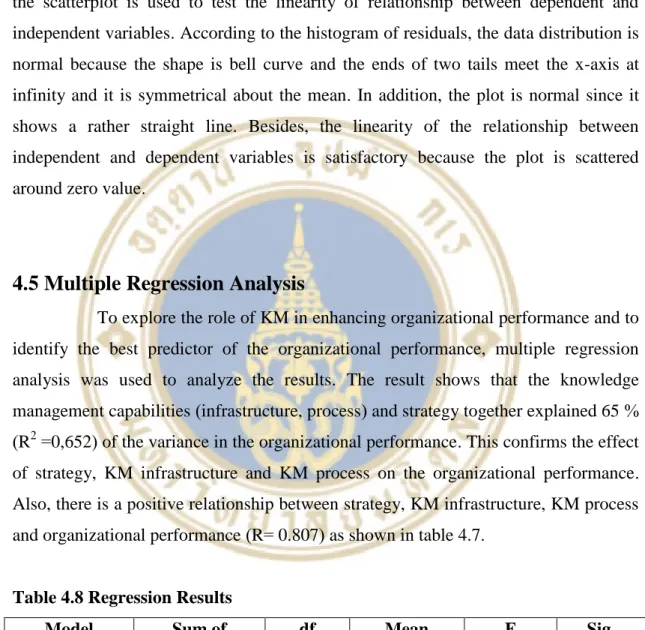THE IMPACT OF KNOWLEDGE MANAGEMENT ON ORGANIZATIONAL PERFORMANCE (CASE STUDY AT PTT). LEADERSHIP AND HUMAN RESOURCE MANAGEMENT). This study aims to investigate the impact of knowledge management on organizational performance specifically in the context of PTT. Survey questionnaires are distributed to Top and middle management employees and analyze the impact of strategy, KM infrastructure and KM process that promote the formulation and implementation of effective KM to improve organizational performance.
The results show that two main factors, namely conversion and application of knowledge have a positive and significant relationship with organizational performance. Because the distinctive competence of human resources, knowledge, skills and experiences of the organization are enablers and knowledge assets of the organization act as the main contributor to obtain competitive advantage. As a result, many companies have paid great attention to knowledge management as an approach to generate specific competencies to enhance organizational performance in order to ensure long-term survival.

Oil and Gas Industry environment
KM at PTT
Due to increased competition in the market, PTT strives to align its business operations with a sustainability strategy by maintaining the balance between a high-quality organization and the pursuit of continuous improvement of technology, innovation and knowledge. It improves business operations based on knowledge, skills, experiences of staff and cooperation between companies within PTT Group. Here, knowledge management capability plays a strategic role to achieve performance and increase external competitiveness.
At the same time, the formulation and implementation of the organization's strategy should take into account the relative contribution of KM practices to improving internal performance. Strategy serves as a building block for effective KM, and the organization must have an associated KM infrastructure to support the KM strategy and process. These three elements of strategy, KM infrastructure and process have a strong impact on the organization and all of these must be aligned.
Methodology
Population and Sample
Expected Outcomes of the study
LITERATURE REVIEW
- Industry Environment
- Inward Focus (Importance of Internal Resources)
- Definitions of Knowledge Management
- Recent Trends on Knowledge Management
- Strategy
- Knowledge Infrastructure Capabilities
- Knowledge Management Process
- Organizational Performance
- Proposed Framework
Therefore, organization's KM infrastructure and KM process act as a capability together with strategy provide distinctive skills to improve enterprise performance in order to achieve competitive advantage. Collaboration is strongly needed to transfer and create effective knowledge within the organization (Sveiby, 1996). More importantly, organization must have open culture to successfully implement KM within the organization.
In order to maintain a competitive position, the organization's knowledge must be protected by developing incentive alignment, employee conduct rules, restrictions, or tracking. Effective development and implementation of the KM infrastructure and process can lead to many positive effects on the organization. Strategy, knowledge management infrastructure and knowledge management process, when aligned and integrated, can lead to effective knowledge management in an organization to increase organizational performance.
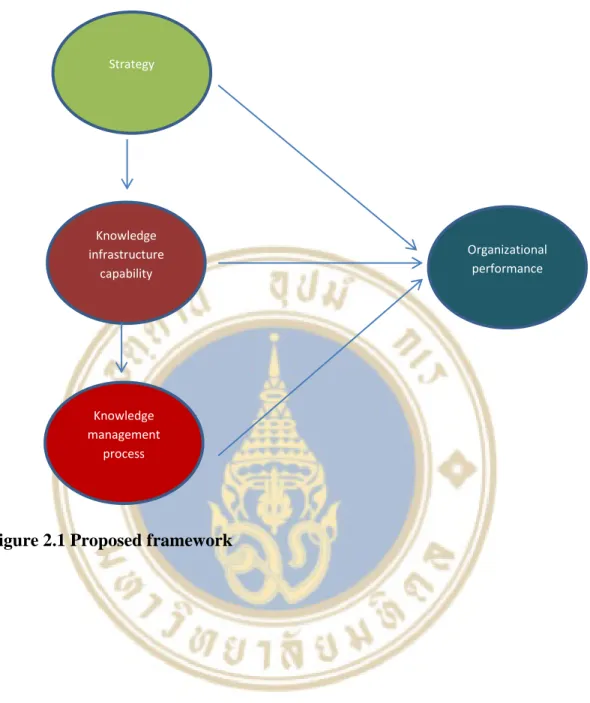
RESEARCH METHODOLOGY
- Research Design
- The Conceptual Framework Development
- Sample Population
- Development of Evaluation Method
- Literature Review
- Questionnaire Development
- Data Analysis
Based on the analysis from the literature review, the impact of knowledge management on organizational performance requires three conditions that enable (1) an organization's strategy, especially a knowledge management-oriented strategy, which is mainly focused on providing distinctive competencies through effective knowledge management to achieve competitive advantage, (2) a knowledge management infrastructure that supports the provision of an environment that can lead to and (3) an effective KM process of acquiring, converting, using, and protecting knowledge among employees. In addition, the data collection is mainly focused on the employees of the KM department, who have a great influence on the effective KM process and the purpose of further development. This research is a qualitative research and analysis of the results of a literature review questionnaire consisting of the following sections: Strategy, Knowledge Management (KM) Infrastructure, Knowledge Management (KM) Process, Organizational Performance and General Issues.
PTT has employees who understand the importance of knowledge for the success of the company (culture of information exchange). HR at PTT has policies and systems in place to recruit and attract employees who are proactive in creating and sharing knowledge. HRM at PTT helps develop performance management processes that focus on knowledge development and sharing.
The third part is about the KM process that consists of knowledge acquisition, conversion, application and storage. The PTT clearly communicates the importance of protecting knowledge. The fourth part is about improved organizational performance, emerges from an effective KM process using KM infrastructure and contains (9) measurement statements. By using KM in PTT we have been able to increase the number of markets (more geographical location).
The use of KM in PTT made the company more responsive to information about the industry or market. The fifth part deals with respondents' personal information, open questions concerning challenges and recommendations to get improvements in KM process and organizational information. Pearson correlation is used to find out the correlation between the elements of strategy, KM infrastructure, KM process and organizational performance.
Multiple regression analysis is a flexible method of data analysis and is used to test the impact of KM on organizational performance in PTT.
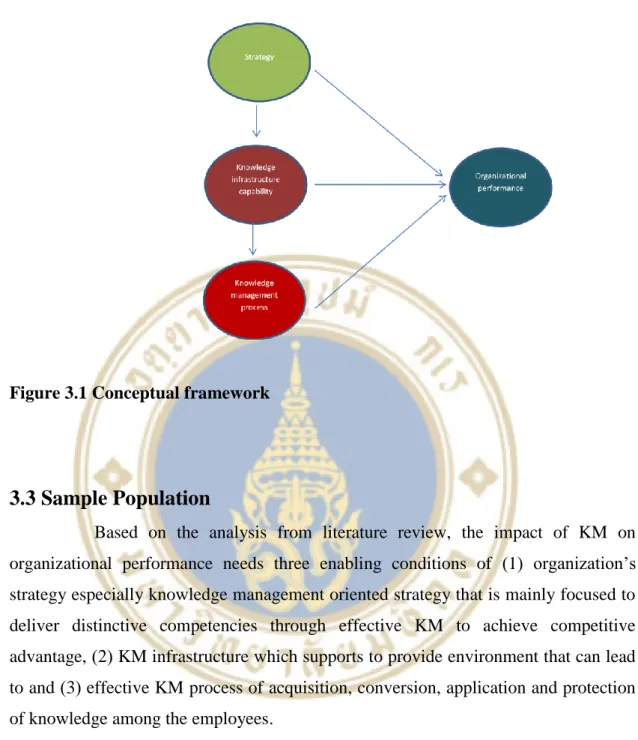
THE RESEARCH RESULTS
- Respondent Demographic Profile
- Descriptive Statistics of Variables
- Reliability Analysis
- Correlation Analysis
- Histogram and Normal Probability Plots Test
- Multiple Regression Analysis
- Coefficient for testing Research Objectives
The data presented in Tables 4.2, 4.3 and 4.4 refer to the level of respondents' agreement with the strategy, KM infrastructure and KM process in PTT. According to the data presented in Table 4.2, the first item “PTT has a written KM policy or strategy” achieved the highest mean value, followed by item (2) “PTT formulates and implements a strategy based on KM initiatives”. On the other hand, the results showed that there is little difference in implementation between strategy, KM infrastructure and process, because the standard deviation range is from 0.5 to 0.8.
To determine the quality of the measurement items, the reliability test is performed through Cronbach's Alpha test. The result shows that the Cronbach's alpha of the construct is 0.93 which is higher than 0.80, the value equal to 0.80 or higher means that the collected data is stable (Pallant, 2005). It is obtained by dividing the covariance of two variables by their product.
A histogram and normal probability plot of the residual are used to determine the normality of the distribution of the error term of the study. In addition, the linearity of the relationship between the independent and dependent variables is satisfactory because the graph is scattered around the zero value. In order to investigate the role of KM in improving organizational performance and to identify the best predictor of organizational performance, multiple regression analysis was used to analyze the results.
The result shows that knowledge management capabilities (infrastructure, process) and strategy together explained 65% (R2 =0.652) of the variance in organizational performance. This confirms the impact of KM strategy, KM infrastructure and KM process on organizational performance. There is also a positive relationship between strategy, knowledge infrastructure, knowledge process and organizational performance (R= 0.807) as shown in Table 4.7.
Although it has no direct impact on the organization's performance, PTT has a well-written KM strategy according to the highest mean value obtained in table 4.2. Thus, it has a significant impact and acts as an enabling factor along with an effective KM infrastructure and process to improve organizational performance.

CONCLUSION AND RECOMMENDATION
- Discussion of Research Findings
- Knowledge Management Process
- Knowledge Management Infrastructure
- KM Strategy
- Challenges concerned with Effective KM Implementation in PTT
- Managerial Implication
- Limitations and Suggestions
- Conclusion
The current research shows that these two aspects of the KM process have a significant impact on organizational performance. The discussion is mainly about the human aspect and not about the technology perspective. The primary purpose of the KM infrastructure is to facilitate the flow of information and knowledge in support of the myriad tasks based on the combination of technology, culture, structure, human resource management and leadership. Instead, it offers 'intermediate outcomes' of KM, such as improved organizational behavior, innovation, individual learning, collective learning and decision-making.
Therefore, the role of KM strategy is mainly to provide supporting KM infrastructure to achieve performance improvement and link the business strategy. Based on the findings, KM process elements of knowledge conversion and application are the most important factors to improve organizational performance. Thus, the role of KM is to create and acquire critical knowledge and make it available to those who can use it in a real-time situation to improve performance.
In general, the main challenge is that the awareness and attitude of the employees about the relative importance of KM and that can prove difficult in maintaining the momentum in creating a culture of knowledge sharing in the organization. Based on the challenges discussed in the previous section, employee attitudes towards the importance of KM should not be ignored and this plays a large role in shaping the culture of knowledge sharing. These processes can help employees understand the contribution of KM to sustaining business success in a competitive environment.
If the study were conducted in different sizes of companies, the additional insights of KM might have been generated. Therefore, future research should conduct the study by conducting interviews to gain in-depth insights of employees' attitudes and needs to expand the scope of KM. There are many research articles that have been done mainly on the topic of KM by focusing on KM infrastructure and process aspects.
Therefore, the role of KM culture plays a major role because KM is embedded not only in documents or repositories, but also in the routines, processes, practices and norms of the organization.
Relationship of Knowledge Management Practices, Competencies and Organizational Performance of Government Services in Malaysia. Quink U., "Exploring knowledge management and intellectual capital in the context of a non-profit organization", MA thesis, Queensland University of Technology, 2008. Ribiere M. & Sitar S., "The critical role of leadership in nurturing a knowledge-supportive culture", Research and Practice knowledge management.
International Journal of Management Science and Engineering Management The relationship of knowledge management practices, competencies and organizational performance of government departments in Malaysia", International Journal of Human and Social Sciences. Theriou N., Maditinos D., & Theriou G., " Knowledge Management Enabling Factors and Firm Performance: An Empirical Research of Greek Medium and Large Firms".
APPENDICES
Knowledge Management Survey
- Culture
- Structure
- Leadership
- Human resources management (HRM)
- Knowledge Conversion
- Knowledge Application
- Knowledge Protection
B Have policies and systems to recruit and attract employees who are proactive in creating and sharing knowledge. C Help with the development. B Allowed us to increase the number of markets (more geographic location) C Helped us add new ones. Are there any knowledge management practices that your firm or organization uses that we did not include in this survey.
Has your organization experienced significant resistance to implementing any of the KM practices currently in use? In order to effectively and accurately analyze the data in the questionnaire, please provide your information below.
